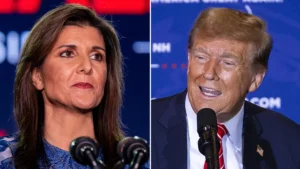
When Shehbaz Sharif first became Pakistan’s prime minister two years ago, he had to persuade a fractious coalition and an angry public to swallow unpopular measures in order to save the nation from default. This time it’s worse.
Shehbaz was named Sunday as the new premier of the world’s fifth-most-populous country after his elder brother and party leader Nawaz unexpectedly passed the baton to him.
The younger Sharif’s position is daunting. Supporters of his jailed rival Imran Khan won the most seats in the February poll and Sharif only regained power thanks to a shaky coalition. He needs to renew a loan with the International Monetary Fund by April to keep the economy afloat – a task that’s likely to fuel public unrest. And he must placate a powerful military that once exiled him.
But the 72-year-old politician has been here before. When he first came to power in 2022, his predecessor Khan had agreed to subsidize fuel prices weeks before he was ousted, placating a population squeezed by Asia’s fastest-rising inflation, but costing the government more than it paid to run the entire federal civil administration. That stalled an IMF bailout that was seen as essential to keeping the economy intact.
At the time, Sharif was informed weeks before taking the premiership that he needed to raise fuel prices to clinch the IMF deal and save the country from default.
“He was convinced really from day one,” said Miftah Ismail, Sharif’s former finance minister. “Then one of our ministers convinced him to wait 15 days. And then every time he would be ready, somebody would say, why don’t you wait three more days?”
It took six weeks for Sharif to persuade his coalition partners to raise prices, a delay that cost Pakistan hundreds of millions of dollars. In the end, he managed to secure the $3 billion loan after taking unpopular steps such as removing fuel subsidies and raising energy costs.
Sharif’s “first stint as PM did not bring him brownie points,” said Majyd Aziz, a prominent businessman in Karachi who has met him many times. “He had minimal control or influence over the coalition partners.”
The fuel-price saga highlights the skills Sharif is likely to need as leader of yet another potentially unpopular coalition.
Sharif’s two main allies said they will support the government only on a case-by-case basis. The biggest partner, the center-left Pakistan Peoples Party, led by election rival Bilawal Bhutto Zardari, declined even to join the cabinet.
Unexpected Return
Shehbaz’s return to power wasn’t even expected. His older brother, three-time prime minister Nawaz was believed to be the party’s pick for the top job after he returned from four years in exile to counter the enduring popularity of Khan.
The failure of Nawaz’s party to win a majority in the election is what prompted him to hand the prime minister role to his younger brother, because Shehbaz was thought to be better suited to running a large coalition, according to people familiar with the family’s thinking, who asked not to be identified as the information is private.
That’s unlikely to mean the elder brother won’t have a say in policy. In his previous term as premier, Shehbaz would make frequent trips to London to seek advice from Nawaz.
And then there’s the army, which ran the country directly from 1999 to 2008 and remains a powerful force in its politics. Shehbaz has been conciliatory with the military, openly praising army chief General Asim Munir.
Still, the Sharif brothers hail from a business family and only got into politics when former Prime Minister Zulfikar Ali Bhutto – Bilawal’s grandfather – nationalized the steel industry in the 1970s.
Their pro-business pedigree remains. In meetings with company executives, Shehbaz is more affable, willing to listen, and able to grasp economic issues, the businessman Aziz said. When he had to raise pensions for government employees in his first stint as premier, he first checked if there was fiscal space to do so.
Chief Minister
The younger Sharif also served for more than a decade as the chief minister of Punjab, Pakistan’s most populous province, where he gained a reputation for being a demanding, occasionally abrasive administrator who would call for site visits at midnight and ask teams for a “25th hour” in a day to get tasks accomplished.
“He had an infinite capacity to work,” said Sibtain Fazal Halim, former director general of the Lahore Development Authority, who worked with Sharif on infrastructure projects including Lahore’s first metro line. “Honest bureaucrats who were not shirkers, for them he was a hero.”
Officials coined the term “Shehbaz Speed” for the pace of his projects, executed by civil servants he had hand-picked and recruited through personal phone calls and breakfast invitations at his Lahore residence.
“The Shehbaz Sharif I knew had a lot of appetite for fight and no time for fools,” said Umair Saif, caretaker federal minister for information technology and telecommunication, who worked with Sharif in Punjab.
But Shehbaz was less adept at public speaking and relationship-building, and never enjoyed his brother’s levels of public support, which has cost him politically, according to people who worked with him.
Shehbaz’s track record has also been marred by corruption allegations. After the military coup in 1999, he was imprisoned and then deported to Saudi Arabia. He spent seven years in exile.
Challenges Ahead
Now his most pressing task may again rile the public. Pakistan’s debt is classified as borderline sustainable, with record-high interest rates and low growth. Inflation has eased but remains above 20%. Sharif must seek a fresh loan of at least $6 billion from the IMF under terms that could be even stricter than before. The prospect of raising taxes is likely to stoke more unrest, according to analysts.



